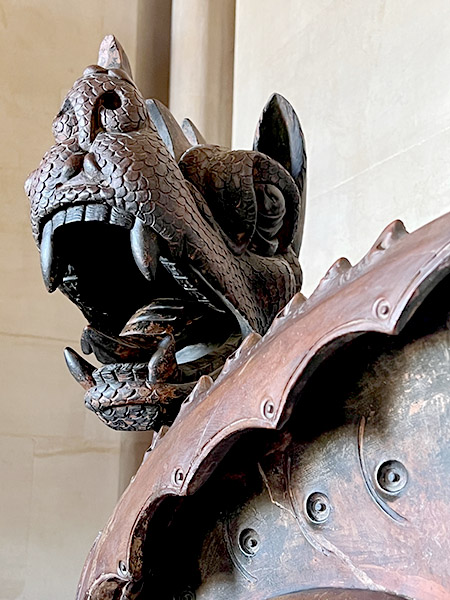From Lady Carnarvon:
Wyverns look a little like dragons but have only two legs, unlike a dragon which has has four, and they are an imaginative mixture of a scaly reptile and dragon type often used in heraldry. Typically a wyvern is depicted resting upon its legs and tail but it can also be shown with its claws in the air and supported only by its tail. These carved figures recall the Anglo-Saxon times and are symbols often associated with the Kingdom of Wessex which was nearly completely overrun by the Vikings around 870AD but was finally united and protected through the military endeavours and the later cultural leadership, of the renowned King, Alfred (849-899AD).Share
Under King Guthrum, the Vikings had swept down from their northern kingdoms and, in a lightning strike, seized much of what is now Wiltshire and from there laid waste to Wessex. Alfred withdrew in haste to the Somerset tidal marshes with what few followers remained. From there he reorganised the fyrd (existing army), calling more to his cause but keeping them to a rota basis to enable him to could raise a ‘rapid reaction force’ to deal with the raiders whilst ensuring that farming could continue, thus preserving food supplies. Apart from mythically burning the cakes (his mind might have been elsewhere), Alfred proved himself a creative and innovative leader on the battlefield. Finally, in May 878, his army defeated the Vikings (Danes) at the battle of Edington and they all sued for peace, creating a north south divide across England.
The centre of Alfred’s world was his royal palace in Winchester from which he developed a network of burghs so that no one was more than 20 miles from the refuge of one of these settlements. In addition, he built new fast ships to create a navy which helped support and protect Wessex and southern England. The very word 'borough' comes from the Anglo Saxon meaning a fortified market place as Alfred needed both to promote trade – markets – and defend the population. Towns today still bear reference to these origins – New-burgh-(bury) is one example which is the town closest to Highclere. (Read more.)




















No comments:
Post a Comment